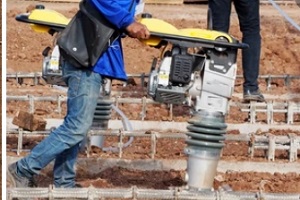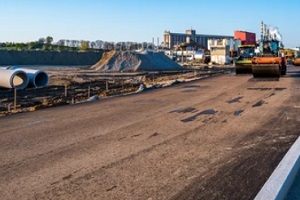 One of the most important steps in preparing a site for any type of construction project is ensuring the soil is in optimal condition to support whatever is built on it. Soil compaction is a vital step for preventing soil settlement, reducing water seepage, increasing load-bearing capacity and providing a project with maximum stability.
One of the most important steps in preparing a site for any type of construction project is ensuring the soil is in optimal condition to support whatever is built on it. Soil compaction is a vital step for preventing soil settlement, reducing water seepage, increasing load-bearing capacity and providing a project with maximum stability.
Most people have seen examples of what can happen when soil is not properly compacted. Whether it’s a buckling road, a yard that fills with puddles when it rains, or the Leaning Tower of Pisa, the damage that can arise when this vital step is skipped can be an inconvenience at best and put buildings and lives at risk in the worst scenarios.
Soil compaction is essential for providing a flat base for all types of projects, but here is a look at some of the top uses for compacted soil.
Buildings
Soil compaction plays a vital role in the construction process as it forms a strong working platform for everything that is built on the space. If soil is not compacted properly, the building will face the risk of settling, developing cracks, draining issues, leaning, buckling and other problems that could compromise its structural integrity. The low cost and effort involved in compaction early in the construction process compared to the benefits it provides makes it an indispensable step in preparing a site for the construction of a home or building.
Compacting soil increases its load-bearing capacity, which is the maximum amount of contact pressure it can accommodate before the soil particles start to move around. In addition to being used prior to starting a construction process, compaction should also be carried out after backfilling or disturbing in-situ soil.
The type of soil is the main criteria for selecting the proper equipment. For granular soils such as sand and gravel, smooth rollers are a good option. They rely on static pressure and may also use impact and vibration. They are particularly useful for the final step of compaction.
For soils that are more cohesive, padfoot and tamping foot rollers are ideal because they employ manipulative force to break the bonds between particles of fine-grained soil. Their tapered feet prevent them from disturbing the soil, which could reduce the soil’s ability to absorb additional water from rainfall.
Smaller projects can use more precise compaction equipment. For example, in confined work areas or very small spaces, lightweight and highly portable tamping rammers can be used. For small to medium jobs, pneumatic rollers are suitable, and additional ballasts can be added depending on the compaction goals.
Highways
 Compaction is used for building highways, including the base, subbase, embankments and subgrade. It is essential for providing a uniform and smooth surface that is capable of handling the heavy loads from vehicles and trucks and varying weather that roads are subjected to without breaking up and posing a hazard to those using the road.
Compaction is used for building highways, including the base, subbase, embankments and subgrade. It is essential for providing a uniform and smooth surface that is capable of handling the heavy loads from vehicles and trucks and varying weather that roads are subjected to without breaking up and posing a hazard to those using the road.
Those who construct the road will consider the types of vehicles that will be using it to determine the ideal width and path of the road, along with the necessary depth for the base material. Roads made to accommodate heavy-duty commercial vehicles, for example, need to be straighter to allow for these vehicles’ limited maneuverability.
A binding agent such as lime or cement may be mixed into the soil with a stabilizing machine prior to compacting it. Normally, the soil is compacted beginning from the outside and working toward the middle using equipment that is suited to the type of soil in question. For example, granular soils are typically compacted using walk-behind rollers, ride-on rollers, or forward/reversible plates, while cohesive soils are usually compacted with trench rollers or rammers prior to road construction.
Pavements
Compaction is often used to increase the load-bearing capacity of subgrade soil as this can also improve the load-bearing capacity of the pavement that is built on top of it, enhancing the pavement’s performance and strength. Compacting the soil can also allow for more economical pavement structures to be used.
Failing to compact the soil to an adequate density means the subgrade could continue to erode or compress after construction. This can cause the pavement to deform or develop cracks. To achieve the optimum density, the subgrade must be at its optimum moisture content prior to carrying out the work.
For greater subgrade support for pavements, binding materials may be used to provide stabilization. Emulsified asphalt is the binder of choice for sandy soils, while lime is typically used on highly plastic soils and cement is ideal for less plastic soils.
Trenches and Backfills
After cables, pipes and bedding have been laid, it is necessary to replace the dirt that was excavated to create the trenches. An excavator is used to replace soil in the trench prior to mechanical compaction. It is essential to compact soil in trenches and backfills to the right level; soil that is overdensified could compromise the underlying utility lines, while under-densifying backfill may lead to soil subsidence in the future.
The soil’s composition, mechanics and moisture content are all considered when determining the best tool to carry out the work. For cohesive materials such as silt and clay, padfoot or sheepsfoot trench rollers and rammers are considered the better choice thanks to their high amplitudes and lower frequencies.
 Granular materials such as gravel and sand, meanwhile, should be compacted using smooth drum rollers or vibratory plates thanks to their lower amplitudes and higher frequencies. When mixed aggregate is being compacted, a vibratory plate compactor works better than a trench roller on account of its larger surface area and quicker travel speed.
Granular materials such as gravel and sand, meanwhile, should be compacted using smooth drum rollers or vibratory plates thanks to their lower amplitudes and higher frequencies. When mixed aggregate is being compacted, a vibratory plate compactor works better than a trench roller on account of its larger surface area and quicker travel speed.
Another consideration is the dimension of the work area. Rammers or tampers are a popular choice for very narrow trenches, such as cable and utility trenches that are several inches in size. Bigger trenches, however, often need trench rollers and plate compactors for greater efficiency.
Get in Touch With Dirt Connections
Give your projects the right start with high-quality soil that has been compacted properly. Get in touch with the residential and commercial soil experts at Dirt Connections today to discuss your project or request a free estimate.
Summary

Dirt Connections was started with one goal in mind: providing quality residential and commercial construction services to clients on time and on budget. Reach out for more information on how we can support your next project.
For your convenience our estimates are free and by appointment. Call 703-940-9949 for a free estimate today!










































